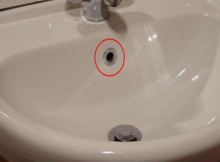Most bathroom sinks feature a small hole located just beneath the faucet, often leaving people puzzled about its function. Some may think it’s just part of the design or assume it serves no real purpose. However, this small, seemingly modest hole actually plays an important role in the sink’s operation, showcasing the thoughtful planning behind the design. In this article, we’ll explore the purpose of this tiny hole, why it’s essential, and how you can maintain it for a fresher, cleaner bathroom.

The Overflow Hole: A Hidden Safety Feature
The small hole in your bathroom sink, known as an overflow hole, is strategically placed about one-third of the way up the basin. While it may seem insignificant, it acts as a safety feature designed to prevent accidental flooding.
How Does the Overflow Hole Work?
The overflow hole connects to the drainage pipe below your sink. Its main purpose is to allow water to escape in case the faucet is left running and the water level rises too high. If the sink begins to fill beyond its intended level, water will enter the overflow hole and safely drain out through the pipe, avoiding the potential mess of water spilling onto the bathroom floor. In short, the overflow hole is there to protect you from accidental flooding and to keep your bathroom dry.
Preventing Overflow with Practical Design
It’s easy to forget about the faucet when you step away to answer a call or attend to something else. In these moments, the overflow hole becomes essential. Once the water level reaches two-thirds of the basin, any excess will flow into this hole and drain into the pipes. This small yet crucial feature keeps your bathroom floors and walls safe from water damage and prevents the hassle of a soggy cleanup.
Situations Where the Overflow Hole Saves the Day
- Forgotten Faucets: It’s easy to leave the faucet running, especially in busy households or when young children are involved. The overflow hole catches water that would otherwise spill over.
- Clogged Drains: If the sink’s main drain becomes clogged and water starts to back up, the overflow hole can provide an alternate path for excess water, reducing the likelihood of a flood.
- Filling the Sink for Various Tasks: Whether soaking laundry or washing items by hand, some people fill the sink up for different tasks. The overflow hole provides peace of mind, acting as a backup if the water level accidentally goes too high.
Overflow Holes and Potential Drawbacks
While the overflow hole is incredibly useful, it can also lead to some maintenance challenges if not kept clean. Its location, often in an awkward and hard-to-reach spot, can allow the buildup of bacteria, mold, and grime. This buildup may lead to unpleasant odors that waft up from the hole and spread throughout the bathroom.

The Hygiene Challenge
Due to the moist environment in bathrooms, overflow holes can quickly become a breeding ground for bacteria and mold. The trapped moisture and lack of airflow make it an ideal environment for unwanted growth, which can lead to persistent odors and even the spread of germs.
Cleaning and Maintaining the Overflow Hole
Thankfully, a simple solution exists to keep the overflow hole fresh and clean. Regular maintenance using everyday household items can help eliminate odors and prevent grime from building up.
Using Vinegar and Baking Soda
One of the most effective ways to clean the overflow hole is by using a mixture of vinegar and baking soda. Here’s how to do it:
- Prepare the Mixture: Combine equal parts vinegar and baking soda. This combination creates a powerful, natural cleaner.
- Apply to the Overflow Hole: Pour the mixture directly into the overflow hole. The natural reaction between vinegar and baking soda will fizz, helping to loosen dirt and dissolve buildup within the pipe.
- Allow It to Sit: Let the mixture sit for 5 to 10 minutes, allowing it to work through the grime and kill any bacteria or mold.
- Flush with Warm Water: After the waiting period, pour warm water down the hole to flush out any remaining residue. This final rinse will clear the pipes and leave the sink smelling fresh.

Repeat Regularly for Lasting Freshness
For optimal results, clean the overflow hole with this method every few months. Consistent cleaning can help maintain a pleasant-smelling bathroom and prevent the buildup of harmful bacteria in hard-to-reach spots.
Additional Tips for a Clean and Fresh Bathroom Sink
Aside from cleaning the overflow hole, there are a few other tips to keep your bathroom sink and drains in top condition:
- Use a Sink Strainer: A sink strainer helps to catch debris and hair, preventing clogs in the drain and overflow pipe. This small accessory can reduce buildup and keep your sink’s plumbing clear.
- Flush the Drain Weekly: Pour hot water down your drain weekly to help dissolve soap scum and prevent grime from building up in the pipes.
- Natural Drain Cleaners: Once a month, use natural cleaners, like baking soda and vinegar, to keep the entire drainage system, including the overflow hole, free from residue and foul odors.
- Limit Harsh Chemicals: Avoid using strong chemicals, which can corrode pipes over time. Instead, opt for natural cleaners to protect both your plumbing and the environment.

Why the Overflow Hole Reflects Good Sink Design
The overflow hole is an example of smart, anticipatory design in action. It’s one of those small details that shows thoughtfulness and consideration for real-life scenarios. While it’s easy to take this feature for granted, the overflow hole plays a critical role in bathroom maintenance and convenience.
Even though it may seem like a minor addition, the overflow hole prevents potentially serious water damage in situations where a small oversight could lead to flooding. It’s an often overlooked, yet highly valuable part of modern bathroom sinks.
Final Thoughts: Appreciating the Little Details in Everyday Design
Though modest, the overflow hole in a bathroom sink is an unsung hero, ready to step in during those small but impactful moments. Its presence means fewer bathroom floods, less worry about water damage, and a simpler, cleaner bathroom experience. Regular cleaning of the overflow hole with vinegar and baking soda helps maintain both hygiene and functionality, ensuring that this helpful feature does its job effectively.
So next time you glance at that small hole under your faucet, remember its purpose—and give it a little maintenance now and then. The overflow hole is one of those small details that, once understood, makes you appreciate the design and thought that goes into even the simplest fixtures in your home.

